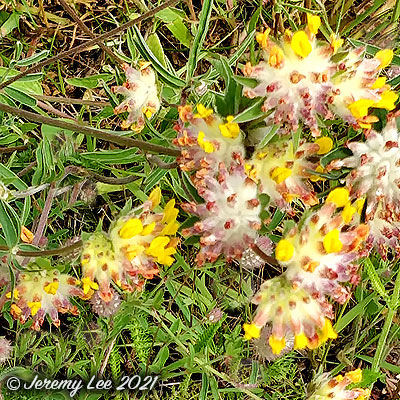
 |
|
Scientific Classifications explained » Amphibians » Ants » Aphids » Bees » Beetles » Birds » Bugs » Butterflies » Caterpillars » Damselflies » Dragonflies » Earwigs » Flies » Frog/Leafhoppers » Fungi » Galls » Grasshoppers » Harvestmen » Hoverflies » Lacewings » Ladybirds » Leaf Mines » Lichens » Mammals » Millipedes » Mosses » Moths » Sawflies » Slugs » Snails » Spiders » Trees & Shrubs » Wasps » Wild Flowers » Woodlice » Postboxes |
UK Nature > Wild Flowers > Yellow Wild Flowers > Anthyllis vulneraria

Scientific Name: Anthyllis vulneraria Common Name: Kidney Vetch Anthyllis vulneraria, more commonly known as Kidney Vetch, Lady's Slipper, Lady's Fingers, Cat's Claws and Yellow Crow's Foot, is a striking and attractive plant. It has traditionally been used in the past as a remedy for kidney disorders. A very variable species, this perennial wild plant is native to the UK, surviving in drier areas until late summer. It is the only source of food for the caterpillars of the Small Blue butterfly. Its flowers are usually yellow, but can vary from orange, to pink or red and has silvery green pinnate leaves. The flower head has a woolly calyx and is clustered with many small flowers, hence one of the common names: 'Granny's pincushions'. Common throughout Britain, it can be found on chalk grassland, sand dunes, rocky banks and cliffs. A variety with red flowers can be found in Pembrokeshire and Cornwall. Its flowers have been used to make yellow dye and its Latin name means 'wound healer' as it has been used for wounds, cuts and bruises. |
|

https://www.uknature.co.uk is a website dedicated to showing the immense diversity of UK nature and wildlife. Our vast range of habitats, from lowland arable to snow covered mountains, from storm-ravaged coastlines to peaceful inland freshwater lakes and rivers, from dry, sandy heaths to deciduous and coniferous forests, all these habitats contribute to the abundance of UK nature. We have wild birds in huge numbers either residing or visiting our shores (597 recorded species as at July 2013) and we must also not forget the humble back garden with its grass lawns, flower beds filled with nectar rich flowers, shrubs and trees, all designed to attract huge numbers of insects such as bees, moths, butterflies and hoverflies; and finally the small ponds which provide safe havens for frogs, toads, newts and even slow worms and grass snakes. www.uknature.co.uk is the showcase for my personal passion, photographing uknature in all its glory. I sincerely hope you all enjoy the fruits of my labours. This site and all images contained therein is © Jeremy Lee 2004 - 2025. All Rights Reserved. Site design by Jeremy Lee. Site development & IT Support by Stuart Lee. |